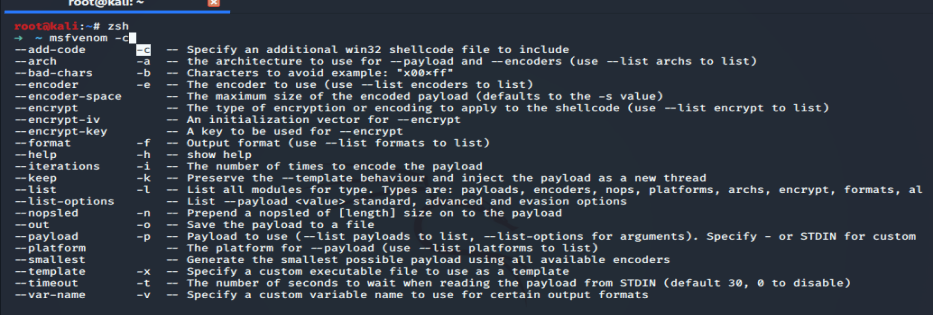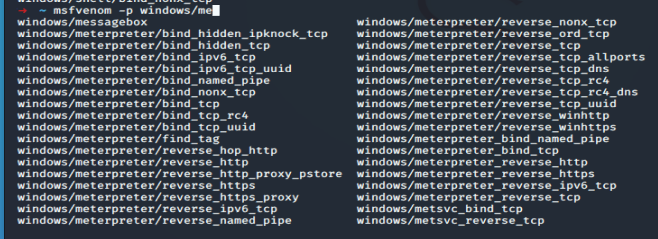2019-12-11:kali linux工具Msfvenom 命令自动补全
msfvenom大家都不陌生,在我们使用MSF进行权限维持,内网渗透的时候都会用到,支持的语言的种类很多。大家都知道我们在使用msfvenom 的时候需要手动输入很多参数,这些参数需要记忆,或记在其它地方,用的时候在查看使用哪个参数,哪条命令,非常的不方便。现在分享一个msfvenom命令自动不全的方法
1,安装oh-my-zsh
官网 https://ohmyz.sh/
官网发的安装命令
sh -c "$(curl -fsSL https://raw.github.com/ohmyzsh/ohmyzsh/master/tools/install.sh)"

或者 sh -c "$(wget https://raw.github.com/ohmyzsh/ohmyzsh/master/tools/install.sh -O -)"

因为kali虚拟机里无法访问https://raw.github.com/ohmyzsh/ohmyzsh/master/tools/install.sh,所以我把网站里的脚本命令全都复制出来,新建了一个脚本直接执行,也可以安装,以下红色字体为脚本代码,如有需要请复制
#!/bin/sh
#
# This script should be run via curl:
# sh -c "$(curl -fsSL https://raw.githubusercontent.com/ohmyzsh/ohmyzsh/master/tools/install.sh)"
# or wget:
# sh -c "$(wget -qO- https://raw.githubusercontent.com/ohmyzsh/ohmyzsh/master/tools/install.sh)"
#
# As an alternative, you can first download the install script and run it afterwards:
# wget https://raw.githubusercontent.com/ohmyzsh/ohmyzsh/master/tools/install.sh
# sh install.sh
#
# You can tweak the install behavior by setting variables when running the script. For
# example, to change the path to the Oh My Zsh repository:
# ZSH=~/.zsh sh install.sh
#
# Respects the following environment variables:
# ZSH - path to the Oh My Zsh repository folder (default: $HOME/.oh-my-zsh)
# REPO - name of the GitHub repo to install from (default: ohmyzsh/ohmyzsh)
# REMOTE - full remote URL of the git repo to install (default: GitHub via HTTPS)
# BRANCH - branch to check out immediately after install (default: master)
#
# Other options:
# CHSH - 'no' means the installer will not change the default shell (default: yes)
# RUNZSH - 'no' means the installer will not run zsh after the install (default: yes)
#
# You can also pass some arguments to the install script to set some these options:
# --skip-chsh: has the same behavior as setting CHSH to 'no'
# --unattended: sets both CHSH and RUNZSH to 'no'
# For example:
# sh install.sh --unattended
#
set -e # Default settings
ZSH=${ZSH:-~/.oh-my-zsh}
REPO=${REPO:-ohmyzsh/ohmyzsh}
REMOTE=${REMOTE:-https://github.com/${REPO}.git}
BRANCH=${BRANCH:-master} # Other options
CHSH=${CHSH:-yes}
RUNZSH=${RUNZSH:-yes} command_exists() {
command -v "$@" >/dev/null 2>&1
} error() {
echo ${RED}"Error: $@"${RESET} >&2
} setup_color() {
# Only use colors if connected to a terminal
if [ -t 1 ]; then
RED=$(printf '\033[31m')
GREEN=$(printf '\033[32m')
YELLOW=$(printf '\033[33m')
BLUE=$(printf '\033[34m')
BOLD=$(printf '\033[1m')
RESET=$(printf '\033[m')
else
RED=""
GREEN=""
YELLOW=""
BLUE=""
BOLD=""
RESET=""
fi
} setup_ohmyzsh() {
# Prevent the cloned repository from having insecure permissions. Failing to do
# so causes compinit() calls to fail with "command not found: compdef" errors
# for users with insecure umasks (e.g., "002", allowing group writability). Note
# that this will be ignored under Cygwin by default, as Windows ACLs take
# precedence over umasks except for filesystems mounted with option "noacl".
umask g-w,o-w echo "${BLUE}Cloning Oh My Zsh...${RESET}" command_exists git || {
error "git is not installed"
exit 1
} if [ "$OSTYPE" = cygwin ] && git --version | grep -q msysgit; then
error "Windows/MSYS Git is not supported on Cygwin"
error "Make sure the Cygwin git package is installed and is first on the \$PATH"
exit 1
fi git clone -c core.eol=lf -c core.autocrlf=false \
-c fsck.zeroPaddedFilemode=ignore \
-c fetch.fsck.zeroPaddedFilemode=ignore \
-c receive.fsck.zeroPaddedFilemode=ignore \
--depth=1 --branch "$BRANCH" "$REMOTE" "$ZSH" || {
error "git clone of oh-my-zsh repo failed"
exit 1
} echo
} setup_zshrc() {
# Keep most recent old .zshrc at .zshrc.pre-oh-my-zsh, and older ones
# with datestamp of installation that moved them aside, so we never actually
# destroy a user's original zshrc
echo "${BLUE}Looking for an existing zsh config...${RESET}" # Must use this exact name so uninstall.sh can find it
OLD_ZSHRC=~/.zshrc.pre-oh-my-zsh
if [ -f ~/.zshrc ] || [ -h ~/.zshrc ]; then
if [ -e "$OLD_ZSHRC" ]; then
OLD_OLD_ZSHRC="${OLD_ZSHRC}-$(date +%Y-%m-%d_%H-%M-%S)"
if [ -e "$OLD_OLD_ZSHRC" ]; then
error "$OLD_OLD_ZSHRC exists. Can't back up ${OLD_ZSHRC}"
error "re-run the installer again in a couple of seconds"
exit 1
fi
mv "$OLD_ZSHRC" "${OLD_OLD_ZSHRC}" echo "${YELLOW}Found old ~/.zshrc.pre-oh-my-zsh." \
"${GREEN}Backing up to ${OLD_OLD_ZSHRC}${RESET}"
fi
echo "${YELLOW}Found ~/.zshrc.${RESET} ${GREEN}Backing up to ${OLD_ZSHRC}${RESET}"
mv ~/.zshrc "$OLD_ZSHRC"
fi echo "${GREEN}Using the Oh My Zsh template file and adding it to ~/.zshrc.${RESET}" cp "$ZSH/templates/zshrc.zsh-template" ~/.zshrc
sed "/^export ZSH=/ c\\
export ZSH=\"$ZSH\"
" ~/.zshrc > ~/.zshrc-omztemp
mv -f ~/.zshrc-omztemp ~/.zshrc echo
} setup_shell() {
# Skip setup if the user wants or stdin is closed (not running interactively).
if [ $CHSH = no ]; then
return
fi # If this user's login shell is already "zsh", do not attempt to switch.
if [ "$(basename "$SHELL")" = "zsh" ]; then
return
fi # If this platform doesn't provide a "chsh" command, bail out.
if ! command_exists chsh; then
cat <<-EOF
I can't change your shell automatically because this system does not have chsh.
${BLUE}Please manually change your default shell to zsh${RESET}
EOF
return
fi echo "${BLUE}Time to change your default shell to zsh:${RESET}" # Prompt for user choice on changing the default login shell
printf "${YELLOW}Do you want to change your default shell to zsh? [Y/n]${RESET} "
read opt
case $opt in
y*|Y*|"") echo "Changing the shell..." ;;
n*|N*) echo "Shell change skipped."; return ;;
*) echo "Invalid choice. Shell change skipped."; return ;;
esac # Check if we're running on Termux
case "$PREFIX" in
*com.termux*) termux=true; zsh=zsh ;;
*) termux=false ;;
esac if [ "$termux" != true ]; then
# Test for the right location of the "shells" file
if [ -f /etc/shells ]; then
shells_file=/etc/shells
elif [ -f /usr/share/defaults/etc/shells ]; then # Solus OS
shells_file=/usr/share/defaults/etc/shells
else
error "could not find /etc/shells file. Change your default shell manually."
return
fi # Get the path to the right zsh binary
# 1. Use the most preceding one based on $PATH, then check that it's in the shells file
# 2. If that fails, get a zsh path from the shells file, then check it actually exists
if ! zsh=$(which zsh) || ! grep -qx "$zsh" "$shells_file"; then
if ! zsh=$(grep '^/.*/zsh$' "$shells_file" | tail -1) || [ ! -f "$zsh" ]; then
error "no zsh binary found or not present in '$shells_file'"
error "change your default shell manually."
return
fi
fi
fi # We're going to change the default shell, so back up the current one
if [ -n "$SHELL" ]; then
echo $SHELL > ~/.shell.pre-oh-my-zsh
else
grep "^$USER:" /etc/passwd | awk -F: '{print $7}' > ~/.shell.pre-oh-my-zsh
fi # Actually change the default shell to zsh
if ! chsh -s "$zsh"; then
error "chsh command unsuccessful. Change your default shell manually."
else
export SHELL="$zsh"
echo "${GREEN}Shell successfully changed to '$zsh'.${RESET}"
fi echo
} main() {
# Run as unattended if stdin is closed
if [ ! -t 0 ]; then
RUNZSH=no
CHSH=no
fi # Parse arguments
while [ $# -gt 0 ]; do
case $1 in
--unattended) RUNZSH=no; CHSH=no ;;
--skip-chsh) CHSH=no ;;
esac
shift
done setup_color if ! command_exists zsh; then
echo "${YELLOW}Zsh is not installed.${RESET} Please install zsh first."
exit 1
fi if [ -d "$ZSH" ]; then
cat <<-EOF
${YELLOW}You already have Oh My Zsh installed.${RESET}
You'll need to remove '$ZSH' if you want to reinstall.
EOF
exit 1
fi setup_ohmyzsh
setup_zshrc
setup_shell printf "$GREEN"
cat <<-'EOF'
__ __
____ / /_ ____ ___ __ __ ____ _____/ /_
/ __ \/ __ \ / __ `__ \/ / / / /_ / / ___/ __ \
/ /_/ / / / / / / / / / / /_/ / / /_(__ ) / / /
\____/_/ /_/ /_/ /_/ /_/\__, / /___/____/_/ /_/
/____/ ....is now installed! Please look over the ~/.zshrc file to select plugins, themes, and options. p.s. Follow us on https://twitter.com/ohmyzsh p.p.s. Get stickers, shirts, and coffee mugs at https://shop.planetargon.com/collections/oh-my-zsh EOF
printf "$RESET" if [ $RUNZSH = no ]; then
echo "${YELLOW}Run zsh to try it out.${RESET}"
exit
fi exec zsh -l
} main "$@"
创建脚本文件vim oh-my-zsh
之后,添加脚本执行权限,chmod a+x
然后./oh-my-zsh执行脚本
2,脚本执行完成,会出现以下界面,oh-my-zsh需要依赖zsh,所以系统没安装zsh的话,需要安装下依赖

3,oh-my-zsh需要依赖zsh,如果系统下没安装zsh,可以使用apt进行安装,apt-get install zsh,因为kali系统默认安装有所以不需要安装

4,安装自动不全脚本,运行命令:git clone https://github.com/Green-m/msfvenom-zsh-completion ~/.oh-my-zsh/custom/plugins/msfvenom/

查看是否已下载好_msfvenom 文件,ls ~/.oh-my-zsh/custom/plugins/msfvenom

使用随便一种文本编辑器打开 ~/.zshrc 文件,我使用的vim编辑器打开添加
vim ~/.zshrc
找到 plugins=(git) 将 msfvenom 添加到里面 plugins=(git msfvenom)

然后在最后添加
fpath=(~/.zsh/completion $fpath)
autoload -Uz compinit && compinit -i

之后保存退出编辑界面
5,实现了msfvenom的自动不全,需要zsh的shell下执行
首先输入zsh进入zsh的shell下
然后输入msfvenom - ,之后按TAB就会出现提示

msfvenom -l

msfvenom -p windows/

2019-12-11:kali linux工具Msfvenom 命令自动补全的更多相关文章
- mycli工具mysql命令自动补全
简介 MyCli 是一个 MySQL 的命令行客户端,可以实现自动补全和语法高亮.MyCli 也可用于 MariaDB 和Percona. 项目地址:http://mycli.net/ 安装 pip安 ...
- msfvenom命令自动补全工具下载=>msfvenom-zsh-completion
msfvenom参数和命令很多,各种payload和encoder经常让⼈眼花缭乱,特别是对英语不好的⼈来说有些命令可能很容易忘记. 所以 Green_m 开发了⼀个zsh插件,可以⾃动化的补全msf ...
- kubectl命令自动补全
kubectl这个命令行工具非常重要,与之相关的命令也很多,我们也记不住那么多的命令,而且也会经常写错,所以命令自动补全是非常有必要的,kubectl命令行工具本身就支持complication,只需 ...
- kubernetes系列(小知识):kubectl命令自动补全
kubectl命令自动补全 linux系统 yum install -y bash-completion source /usr/share/bash-completion/completions/d ...
- kubectl 命令自动补全
kubectl 命令自动补全 在linux上 # yum install -y bash-completion # source /usr/share/bash-completion/bash_com ...
- Docker 命令自动补全?要的
前言 不知道这个小伙伴有多久没用过 Docker 了, 突然对我说 Docker 命令怎么发生变化了 docker run ... #变成了 docker container run ... 他说,本 ...
- 命令自动补全模块rlcomplete
rlcomplete定义了针对readline模块的命令自动补全函数. 当在unix平台下导入这个模块之后(前提是readline模块可用),一个Complete的实例会自动生成,并且 ...
- Mac 终端实现快速定位命令 自动补全目录
基于macOS oh-my-zsh 切换终端主题 incr.zsh 实现快速定位命令 自动补全目录 效果预览 步骤 1.安装 oh-my-zsh sh -c "$(curl -fsSL ht ...
- linux 命令自动补全包
linux 其他知识目录 rhel7如果使用最小化安装后,tab键默认是不能自动补全命令的 执行yum install bash-completion之后重启系统正常.
随机推荐
- 转 C# GDI+ 实现橡皮筋技术
http://www.cnblogs.com/arxive/p/6080085.html 应该有很多人都在寻找这方面的资料,看看下面我做的,或许对你会有所帮助,但愿如此. 为了实现橡皮筋技术,我用了两 ...
- H5表单新特性
1.HTML5表单新特性之——新的input type <input type=" "> HTML5之前已有的input type: text.password.rad ...
- git 把其他分支上的文件拿来覆盖本地
1:git checkout oldversion -- 文件地址 2: 一个分支从某个角度讲也像是一次commmit,也是有向无环图的一个点
- STM32定时器配置(TIM1、TIM2、TIM3、TIM4、TIM5、TIM8)高级定时器+普通定时器,定时计数模式下总结
文章结构: ——> 一.定时器基本介绍 ——> 二.普通定时器详细介绍TIM2-TIM5 ——> 三.定时器代码实例 一.定时器基本介绍 之前有用过野火的学习板上面讲解很详细,所以 ...
- Sqlserver2008[索引]
SQL索引有两种:聚集索引.非聚集索引 目的:提高sqlserver 系统的性能,加快数据的查询速度与减少系统的响应时间 注意点:一个表只能有一个聚集索引,但可以有多个非聚集索引 索引的存储机制: 聚 ...
- 用js刷剑指offer(复杂链表的复制)
题目描述 输入一个复杂链表(每个节点中有节点值,以及两个指针,一个指向下一个节点,另一个特殊指针指向任意一个节点),返回结果为复制后复杂链表的head.(注意,输出结果中请不要返回参数中的节点引用,否 ...
- C#预处理器指令——学习
若要详细了解如何使用 C# 预处理器指令选择性地编译代码段,请参阅 #define(C# 参考)和 #if(C# 参考). #define(C# 参考) 地址:https://docs.microso ...
- MySQL进阶18- 存储过程- 创建语句-参数模式(in/out/inout-对应三个例子) -调用语法-delimiter 结束标记'$'- 删除/查看/修改-三个练习
/* MySQL-进阶18 存储过程 和 函数 存储过程和函数:类似于java中的方法 好处: 1.提高代码的重用性 2.简化操作 */ #存储过程 /* 含义: 一组已经预见编译好的SQL语句的集合 ...
- Java锁--Semaphore
转载请注明出处:http://www.cnblogs.com/skywang12345/p/3534050.html Semaphore简介 Semaphore是一个计数信号量,它的本质是一个&quo ...
- framebufferfetch in vulkan
framebufferfetch在ogles上是个扩展 到vulkan这里做成一个基本功能了 对应的是subpass(对照metal) 不同renderpass不能stay on chip 只有sub ...
